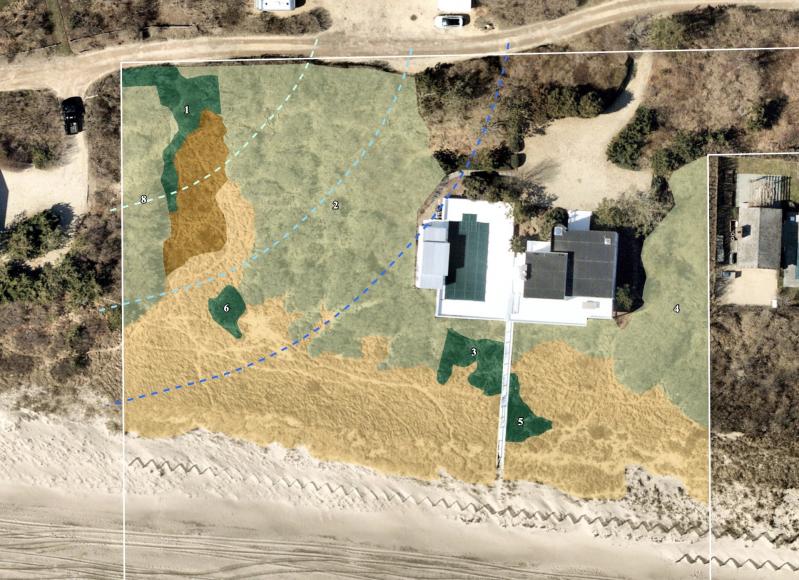Jimi Hendrix got it. “Castles made of sand fall in the sea, eventually,” he sang. Makes sense. Sands shift. But would the history of rock-and-roll have been different if Jimi had built his castle over and above Federal Emergency Management Agency standards?
A new application for a house in the dunes at 124 Beach Lane in Wainscott seeks to do just that — stand the test of time. The house would sit within sight of the 30 acres of land recently preserved by the town for $56 million.
Even if the East Hampton Town Zoning Board of Appeals wanted to deny it, Denise Schoen, a lawyer with the Adam Miller Group, speaking for the applicant, worked hard to tie the board’s hands with precedent at its Jan. 21 meeting. She told the board that two earlier applications, larger and less resilient, though never built, had been approved by the board in the last 25 years.
The current plan is to demolish the existing 2,550-square-foot house and build a 5,898-square-foot one-story residence (“the most modest oceanfront house we could do in this situation,” according to its architect, Christopher Coy) with a pool and 3,571 square feet of decks and terraces. The proposed house doesn’t need a zoning variance, but because there are freshwater wetlands, barrier dunes, and beach vegetation on the 3.2-acre parcel, a natural resources special permit is required from the Z.B.A.
“This section of Wainscott oceanfront has been one of the most severely flood and erosion-prone locations within the town,” wrote Brian Frank, the assistant planning director, in a Jan. 2 technical analysis of the application. Adjoining properties have “obtained numerous building permits over the years to add significant volumes of beach-compatible sand to augment or rebuild the barrier dunes that are the primary protective formations for the residential improvements on the respective properties.” In fact, between 2005 and 2013, the owner of 124
Beach Lane added 3,000 cubic yards to the beach on six separate occasions.
“The fact that the dunes need to be nourished doesn’t mean necessarily that this project is going to have a negative impact on them, it’s just part of the process of maintaining a dune system that can change over time,” Ms. Schoen told the board.
During Superstorm Sandy, the dune was destroyed and a house to the west was obliterated. Wainscott Pond briefly became part of the ocean. In 2013, the dune was reconstructed and its crest has been stable since at least 2018. Mr. Frank seemed unconvinced that it was the right place to build much.
“The vulnerability of this property to coastal erosion and flooding makes it a poor candidate to aggressively redevelop as currently proposed,” he wrote. “The application should be redesigned to significantly reduce the scale and intensity of the new development.” At the meeting, he described the difference between a flood zone and a velocity flood zone like that in which the home will sit. In a velocity flood zone, you don’t just get an inch of standing water on your lawn for a few hours. Instead, structures have the potential to be “Inundated directly by wave action, direct wave attack,” he told the board.
“The applicant has taken the recommendations of FEMA and of the [Planning Department] in serious consideration and has decided to build to velocity flood zone standards,” Ms. Schoen told the board. The house will be one story with “breakaway walls” underneath, which will allow water to flow underneath “if we ever hit that 100-year storm.” There was no discussion about what happens to those walls in that scenario.
Nonetheless, while that change appeased the town (“The incorporation of building to velocity flood zone specifications in this area where they’re not mandated is a significant raising of the bar in terms of coastal protection,” said Mr. Frank), it angered neighbors.
“In this case they’re not complying with FEMA, they’re exceeding FEMA,” said Andy Hammer, an attorney speaking for two neighbors. “I think there’s an obvious reason why you would want your first floor to be as high as you could possibly have it on this property. The view gets lovelier and lovelier each foot you go up.” He said it could be lowered to reduce the home’s visibility.
Mr. Coy, the architect, labeled Mr. Hammer’s analysis a “misconception.” “We’re not raising the thing because we want to raise it. We’re raising it because we are complying with [flood zone standards],” he told the board.
Criticism from another neighbor was on the light side. He called to say he had no problem with the “compliant, if architecturally undistinguished,” house, other than the placement of a generator in a setback zone. Ms. Schoen agreed to move it.
The need for a pool was not questioned, and Mr. Frank applauded the plan to reorient it so it would be 40 feet farther east, limiting the westward sprawl of development, where the erosion danger was most extreme. He also praised a new 50-foot easement that would extend from the toe of the dune landward and said a revegetation plan, which included no lawn, was adequate.
Perhaps signaling an eventual vote of approval, Ed Johann, a board member, and Roy Dalene, the board chairman, worried most about protecting the dune during construction. “In all of these cases we’re concerned that the construction demolition happens from the landward side, that we don’t see equipment on the seaward side on the top of the dune,” said Mr. Johann.
Ms. Schoen agreed to a list of mitigations that would protect the dune during construction and the public hearing was closed.




